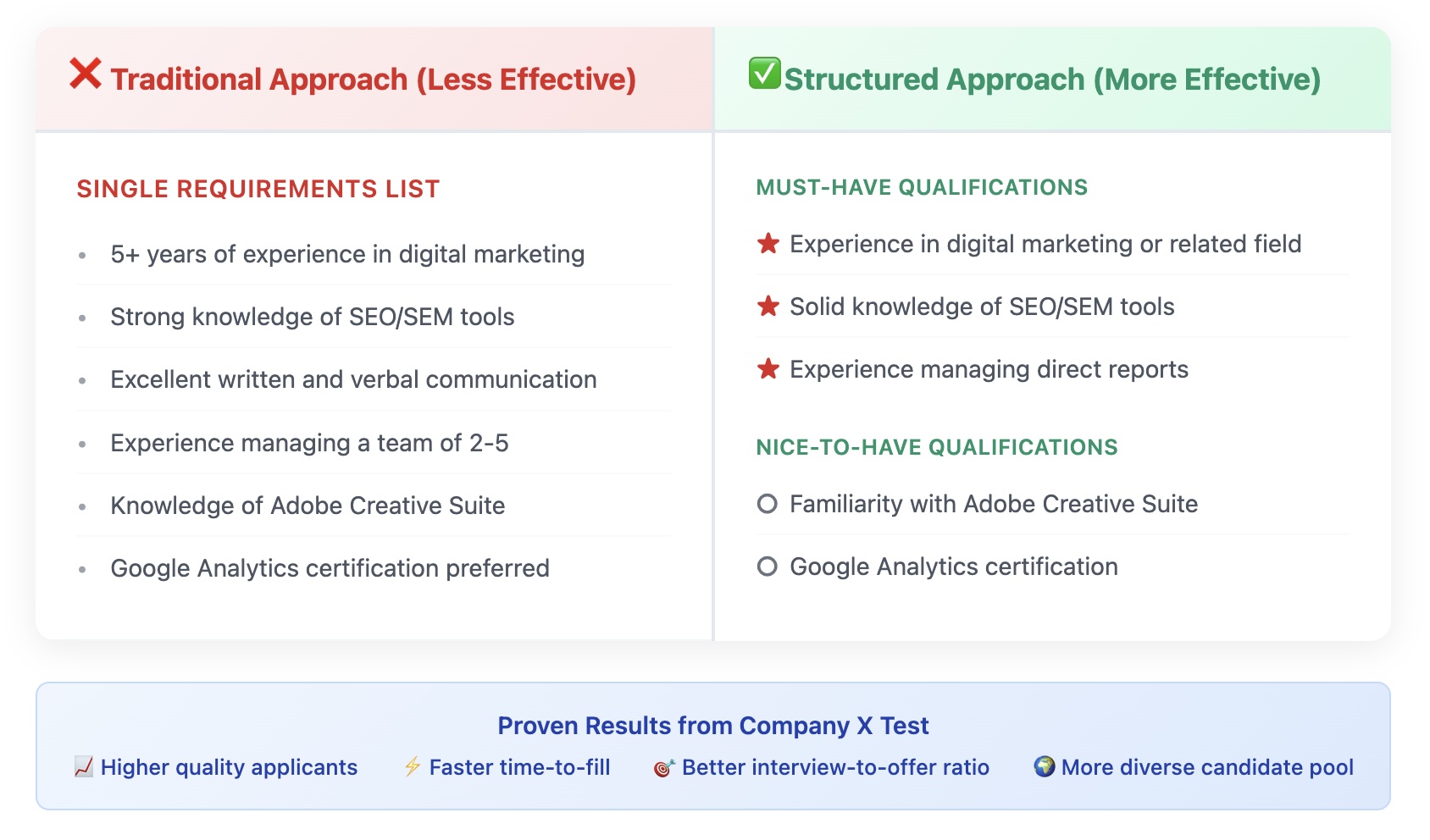According to research from LinkedIn’s Future of Recruiting, 87% of talent acquisition (TA) professionals indicate that recruiting is becoming more strategic. This indicates a shift in the role of recruiting leaders towards a focus on driving business change.
Knowing the difference between sourcing vs. recruiting is essential in creating a smart and strategic hiring plan for talent acquisition. Let’s dive into what each is and the sourcing and recruiting processes.
Contents
What is sourcing?
What is recruiting?
Sourcing vs. recruiting: The key differences
Sourcing and recruiting as a process
FAQ
What is sourcing?
Sourcing identifies, attracts, and engages potential candidates who may fit the company’s workforce but are not currently looking for a job. It’s the initial stage in talent acquisition, setting the foundation for successful hiring.
The goal is to build a qualified talent pool that can be recruited for future roles. Sourcing decreases time and cost per hire while improving the hiring quality since these people are already pre-vetted.
In the Employ’s Quarterly Insight’s report, benchmark data indicates that one-third of the time spent hiring is on sourcing, regardless of how fast the hiring process is. With 53% of companies spending three to four weeks to fill an open role, approximately 7 to 10 days are spent sourcing talent for the position.
Let’s further unpack what sourcers do during this time in the hiring process:
Key responsibilities of a sourcer
- Work with the hiring managers and recruiters to provide the company’s staffing requirements and align their activities in the talent acquisition process. Understand the job descriptions and each role’s specific skills, experience, and cultural fit
- Research candidates on online platforms like LinkedIn and job boards
- Participate in job fairs and industry networking events to source potential candidates
- Build relationships with potential candidates by sending outreach emails and messages and posting on social media. Engage candidates by answering their questions and informing them about company updates and future opportunities
- Post the latest industry trends, company news, and hiring information to update candidates
- Determine the most suitable candidates by reviewing resumes and conducting interviews. Present shortlisted candidates to recruiters to be considered for the company’s current vacancies
- Track and analyze data to identify which sourcing strategies are working and which are not
- Mantain sourcing tools and databases to ensure smooth candidate sourcing and management
- Continuously learn and adapt to changes in talent acquisition practices and technologies.
What is recruiting?
Recruiting is finding and hiring the best candidate with the skills, experience, and culture fit for the role and the organization. Recruiting improves the quality of hires by going through a systematic and fair selection process.
A strong recruitment process guarantees a positive candidate experience and employer brand because well-organized and professional hiring procedures reflect positively on the company. Candidates who are not selected still feel valued and respected because they receive clear expectations and timely updates during the application process. They may also be more likely to apply for future opportunities.
LinkedIn reported the top skills recruiters need in the future are communication skills (78%), relationship building (73%), adaptability (58%), problem-solving (53%) and business acumen (51%).
Key responsibilities of a recruiter
- Work with hiring managers to understand the job requirements. Discuss the daily responsibilities, specific skills, and experience the target candidate needs
- Develop a recruitment strategy based on the recruiting timeline and budget
- Work with the sourcing team to identify platforms to source candidates
- Prequalify applicants by screening resumes and assessing relevant qualifications for shortlisting
- Conduct phone, video, or face-to-face interviews to gain a deeper understanding of the candidate’s qualifications and potential fit for the position and probe for information that’s not included in the resume
- Use tests and assessments to evaluate the critical skills needed for the role
- Perform background checks and references to know the candidate’s work history and past performance from previous employers and colleagues
- Present the best candidates to the hiring manager based on the results of the interviews, background checks, and assessments
- Decide with the hiring manager to select the best candidate and extend the job offer
- If salary negotiations are involved, engage with the candidate to reach mutually agreeable employment terms
- Onboard the new hires to ensure they feel welcome and facilitate smooth integration with the company
- Keep all candidates informed throughout the process, providing timely updates and offering feedback even if not chosen for the position
- Track and review hiring metrics to measure the effectiveness of recruitment strategies and work on tactics that need improvement
- Maintain recruiting tools and databases for a seamless candidate experience and management.
- Stay updated with the newest recruitment industry practices and technologies.
HR tip
Make sure that your recruitment practices comply with legal and ethical standards. Compliance with relevant employment laws and regulations can help avoid lawsuits and enhance your company’s reputation.
Sourcing vs. recruiting: The key differences
Here are the critical differences between sourcing and recruiting:

Sourcing and recruiting as a process
Though there are distinct differences between sourcing and recruiting, they complement each other to create a smooth and effective hiring process:
1. Building a talent pool
Sourcing lays the groundwork. Sourcers build a robust talent pool by actively searching and attracting potential candidates who can be future employees. And when a company starts hiring, recruiters don’t start from scratch. They can easily search for candidates in this talent pool, so they don’t have to spend money and effort on advertising and job boards.
2. Targeting the right talent
Sourcers use various tactics to reach candidates, targeting well-qualified candidates not actively looking for new employment. They initially source candidates that have the skills and experience the company may need in the future.
They also look for applicants who have the right culture fit for the organization. Then, recruiters refine the selection process. They assess the sourced candidates using interviews, tests, and reference checks to identify individuals who best match the company’s requirements.
3. Efficiency and effectiveness
Sourcing expedites the recruitment process. Whenever the company hires, recruiters can access a ready pool of pre-qualified candidates anytime, contributing to higher hires and filling open positions more quickly.
4. Employer branding
Sourcing builds relationships by proactively engaging with candidates even without immediate openings. The goal is to create a positive impression in the candidates’ minds and nurture relationships through regular communication.
Meanwhile, recruiting uses digital marketing strategies to showcase company culture and values during the hiring period.
5. Better candidate experience
Sourced candidates are more likely to have a seamless applicant experience from application to onboarding because they are already familiar with the company based on constant communication with the sourcers ahead of the job vacancy.
6. Continuous collaboration
Sourcers give recruiters feedback about potential candidates’ skills, experience, and availability. Meanwhile, recruiters provide insights based on their interactions with candidates to help refine future sourcing strategies. Open communication between sourcers and recruiters helps adjust strategies based on real-time feedback.
7. Strategic alignment
Sourcing and recruiting functions must align with the organization’s talent acquisition strategy to ensure a cohesive and efficient hiring process.

The sourcing process explained
Building a solid pipeline of candidates starts with the sourcing process:
- Define your job requirements: Understand the skills and experience required for the role. Identify the traits needed to be considered an ideal fit for your company’s values and culture.
- Plan your sourcing channels: To identify potential candidates, use different platforms to source your candidates, like job boards, social media, and virtual career fairs. Use Boolean and other advanced search techniques to refine and optimize searches on platforms like search engines and professional networking sites.
- Employ different sourcing strategies: Boost your online sourcing by combining with offsite or face-to-face sourcing strategies like employee referrals, job fairs, and partnering with colleges and universities.
- Build relationships: Once you’ve identified potential candidates, connect with them through DMs, SMS, emails, and face-to-face meetings. Use social media to show your employer brand, employee stories, and testimonials.
- Engage with passive candidates: Reach out to passive candidates who are considered a good match with their abilities and experiences. They may not be looking for a job right now, but they may be in the future.
- Document and track candidate engagement: For future reference, keep detailed information about your candidate and your interactions with them using your company’s ATS. Make sure they stay updated all the time.
- Screen and shortlist: Screen resumes to see if candidates have the essential qualifications and filter out those who don’t qualify.
- Maintain talent pipelines: Continuously build and nurture a pool of candidates for current and future roles.
- Collaborate with the HR team: Maintain regular communication with recruiters to understand the company’s staffing needs and get their insights on the quality of candidates’ sources. You can also speak with other HR team members to get their feedback on the types of candidates that excel and stay with the company so you can improve your sourcing skills to target those individuals.
- Evaluate and optimize: Regularly assess the effectiveness of your sourcing strategies and tweak them based on feedback and the outcome. Also, check labor market updates and industry trends to ensure your sourcing strategies remain competitive, relevant, and effective.
- DEI compliance: Ensure your sourcing efforts adhere to legal and ethical standards and promote diversity and inclusion in candidate pools.
The recruiting process explained
This overview provides a snapshot of the key steps and considerations involved in the recruiting process:
- Receive job requisition: Hiring managers give a job description and requisition detailing the role’s responsibilities, required qualifications, and experience.
- Create a recruitment plan: Create a hiring plan outlining the recruitment strategies, assessment methods, and the timeline for the hiring process.
- Post job openings: Craft job descriptions based on the received job requisition. Advertise job vacancies on the website’s career page, social media, and job boards.
- Screen candidates: Review resumés to identify applicants who meet the job requirements.
- Perform initial job interviews: Speak with the candidates to review their qualifications, interest in the job, and cultural fit with the organization.
- Conduct pre-employment assessments: Administer tests to guarantee candidates have the right abilities and skills to perform their jobs.
- Coordinate the final interview with the hiring manager: Schedule and facilitate final interviews with the hiring manager to evaluate the candidate’s suitability with the team and the role.
- Run background checks and references: Verify candidates’ background information, contact references, and professional history to ensure the candidate doesn’t have lousy employment history or criminal records that can threaten the organization’s safety and reputation.
- Extend the job offer: Offer the role to the selected candidate, including details about compensation, benefits, and work conditions.
- Negotiate: Sometimes, candidates negotiate salary, benefits, and employment terms with the recruiter.
- Onboard: Facilitate the onboarding process for the new hire, including orientation and paperwork.
HR tip
Conduct candidate surveys. Collect their feedback to improve your candidate experience and your hiring process.
Key takeaway
Sourcing and recruiting are essential parts of the talent acquisition process. While they have specific functions, they work best when combined, creating a more efficient hiring system.
Sourcing is like casting a wide net to attract the most qualified candidates through outreach messages while recruiting narrows it down by selecting the most suitable candidate for the position by screening resumes, interviewing, and evaluating via assessments.

FAQ
Sourcing and recruiting are parts of talent acquisition but serve specific purposes and functions.
Sourcing is often proactive and ongoing, building a talent pipeline before the company has an open position. Recruiting is usually reactive and focuses on filling the immediate vacancy.
Sourcers research and reach out to potential candidates to build a talent pool. Recruiters evaluate the best candidates from the talent pool and offer them the position. Sourcers engage and maintain regular interaction with the candidates. Recruiter works with the hiring manager to select and hire the best candidate after screening, assessment, and interviewing.
Sourcing is the initial phase of the talent acquisition process. Sourcers pool of qualified individuals who might be interested in the opportunity, even if they’re not actively searching for a new job.












